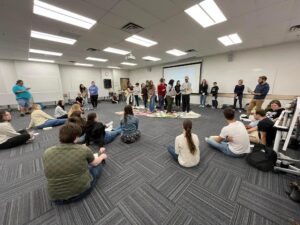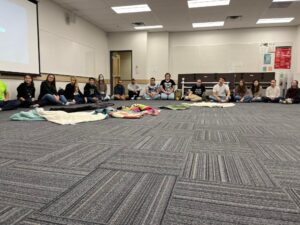
This is the second time that I have had the opportunity to participate in the blanket exercise. The first time I experienced it was in my first year of university in an elective education course. I’m glad that I got the chance to participate a second time because when I did it before, I had not learned very much about Indigenous peoples and the impacts of colonization. It was a meaningful exercise but I did not have as much knowledge on the topics involved as I do now.
The second time participating in the blanket exercise was very powerful. The entire experience was a very clear visual of what Indigenous peoples went through as a result of colonization. At first, everyone was squished together on their blankets and looking around at each other. The mood still felt pretty light at that point. Once the discussion started and the scripts began to be read it became concrete quickly because we could see the impacts each event had. When the colonizer came through and read the piece about disease spreading throughout the Indigenous community about 10 people stepped off of the blankets. It was a significant portion of the class. When the remaining people had to fold their blankets up and stand on a small piece to represent the loss of land some people had trouble balancing on their new spaces. I think that was a good representation of the uncertainty and loss of rights. The overall exercise was a good way to learn about the things Indigenous Peoples went through in a meaningful way that will be remembered.
At the end of the blanket exercise we did a sharing circle. I liked hearing everyone’s thoughts on the exercise when we were in the circle because we could see everyone clearly. One of the main takeaways from the exercise was the fact that it was a powerful visual. It is one thing to talk about it in classes or hear a lecture but actually participating in the learning makes it much more real. We can talk about the different things like loss of land, disease, residential schools and the huge numbers of Indigenous Peoples that were affected but it seems so abstract until you actively see the people leaving the blankets. I think this would be a good exercise to bring into classrooms to teach students especially because it can be adapted to different age ranges and abilities.
